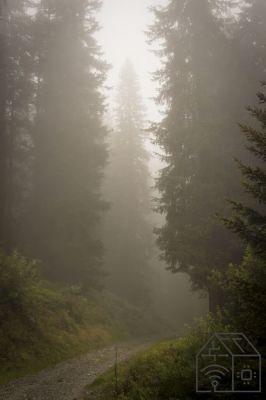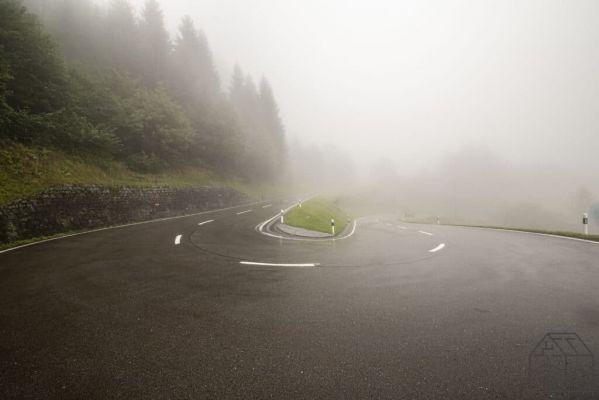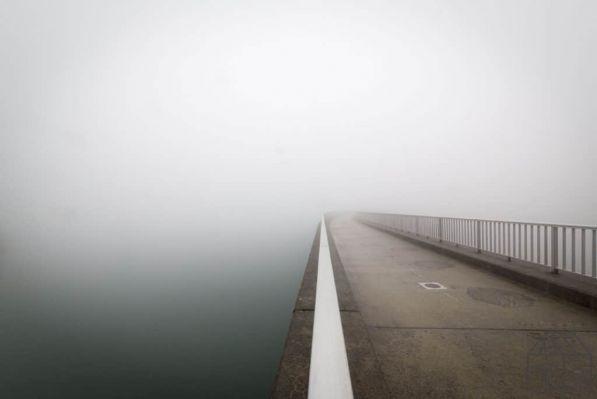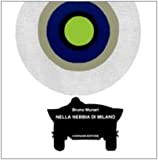
Winter days can have interesting variations in lighting. One of the most difficult to exploit is certainly the day with the fog. Photographing in the fog is certainly an exercise in composition and reasoning, let's see some ideas to transform an uninteresting situation into something more intriguing.
Fog and the absence of light direction
The atmospheric phenomenon of fog leads to a flattening of the scene. Light comes from almost all directions as opposed to a sunny day when the light is well defined. The typical light of the foggy day therefore does not produce visible shadows but at most slightly darker areas. At this juncture the textures of the materials flatten making each object flatter and smoother.
Depth planes
The fog envelops every area of the scene that we look at with our eyes and with our lenses. If we study the shot well we will see that each object in the scene has its own level of gray, different from the closest and farthest objects.

All these levels of gray build a series of scenographic wings that highlight the depth of the scene.
So even if the environment is lost at first sight, we can reconstruct it trying to frame sequences of similar objects. This reconstruction will then go to rely on natural ability of the eye (and of the human mind) to complete a situation by adding details.
Photographing in the fog: loss of horizon
The fog prevents us from seeing into the distance, making everything over 10-15 meters gray. A scene that frames a road, for example, gets lost in thin air, leading our mind to build its shape as desired.

Depending on the lens used, we can exacerbate this loss of horizon. With the wide-angle lenses we will still have a good definition of the environment while with the lenses that are gradually longer the environment will be less and less defined with a more pronounced limbo effect.
The negative space
The great homogeneity of the sky is a good opportunity to take advantage of the composition techniques with negative space. It is a question of abandoning the rules of thirds and the golden section for a while to play on large empty spaces. Photographing in the fog therefore allows us to position the subject at the edges of the image and leave a large homogeneous space; this space contains a very slight nuance that differentiates it from an empty space.

Negative space composition techniques allow you to create light images due to large homogeneous areas. The presence at the edges of the subject, with its graphic forms, contributes to the balance of the composition.
A narrative space
Another exploitable aspect of fog is changing a subject. As the subject moves away from us, its characteristics will change: loss of colors, loss of black, loss of details.
When the subject moves away from the point of recovery it merges more and more with the landscape until it becomes part of it. When, on the other hand, the procedure is reversed, it is the landscape that slowly releases the subject; only near the point of recovery will the subject reveal itself for what it is.

The narrative composition can be done by mounting different images or by blending them in the same frame. Those who like the use of the GIF format can create quick impact mini videos.
Photographing in the fog: take advantage of editing
The editing phase is important to emphasize the feeling of fog. Here are some Photoshop / Lightroom tips to emphasize our images:
- To increase exposure approximately 0,3 - 0,7 stops (each software's exposure slider is set to stops)
- increase the value of blacks, to compensate for the lack of contrast
- choose one color temperature warmer to add a golden effect
- slightly increase the value of Vibrance to give strength to the colors. Avoid using Saturation
- Use the sliders carefully Texture / Clarity to make details more visible. Don't overdo it

Photographing in the fog is a small challenge that leads us a lot to think about the framed subject and the composition itself. It is also a way to take advantage of a situation that at first sight does not seem favorable at all; the material produced is then useful for our editing training, both corrective and creative for the exploration of filters.
Discount
 In the fog of Milan. Ediz. Italian and English
In the fog of Milan. Ediz. Italian and English
- Munari, Bruno (Author)


























